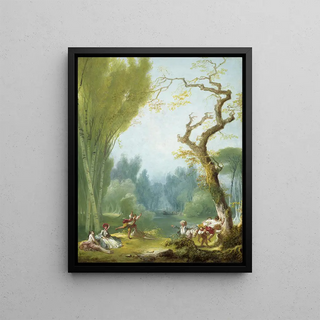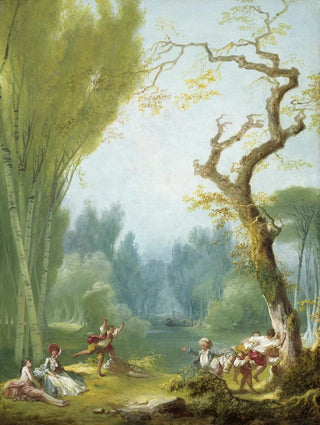Art print | A game of horse and rider - Jean-Honoré Fragonard


View from behind

Frame (optional)
In the vibrant universe of 18th-century art, the artwork "Un jeu de cheval et de cavalier" by Jean-Honoré Fragonard stands out for its charm and liveliness. This painting, which evokes the lightness of aristocratic pleasures, transports us to a world where nature and play intertwine harmoniously. The artist, renowned for his mastery of movement and light, manages to capture a fleeting moment, an almost playful scene where the rider and his steed seem to dance across the canvas. Through this art print, the piece invites the viewer to immerse themselves in an atmosphere of joy and freedom, typical of the Rococo era.
Style and uniqueness of the work
Fragonard's style is undeniably marked by a particular sensitivity, a way of handling color and light that is unique to him. "Un jeu de cheval et de cavalier" perfectly illustrates this approach. The pastel shades, delicate contours, and play of light create an ambiance that is both intimate and festive. The artist succeeds in infusing a dynamic quality into the scene, where the movement of the horse and the expression of the rider evoke a certain euphoria. The composition, though seemingly simple, reveals a complexity in how the elements are arranged, each detail holding significance. This work is a celebration of life, a tribute to the beauty of moments shared between man and nature.
The artist and his influence
Jean-Honoré Fragonard, born in Grasse in 1732, is one of the emblematic figures of the Rococo movement. His work is characterized by a lightness and sensuality that reflect the aspirations of an aristocracy seeking pleasure and refinement. Fragonard successfully established himself in the artistic circles of his time, influencing many contemporaries with his innovative style. He also played a key role in the evolution of French painting, incorporating elements of daily life and human emotions into his compositions. His ability to capture the joy and carefree manners of his era has left a lasting imprint, making him a precursor of a more

Matte finish

View from behind

Frame (optional)
In the vibrant universe of 18th-century art, the artwork "Un jeu de cheval et de cavalier" by Jean-Honoré Fragonard stands out for its charm and liveliness. This painting, which evokes the lightness of aristocratic pleasures, transports us to a world where nature and play intertwine harmoniously. The artist, renowned for his mastery of movement and light, manages to capture a fleeting moment, an almost playful scene where the rider and his steed seem to dance across the canvas. Through this art print, the piece invites the viewer to immerse themselves in an atmosphere of joy and freedom, typical of the Rococo era.
Style and uniqueness of the work
Fragonard's style is undeniably marked by a particular sensitivity, a way of handling color and light that is unique to him. "Un jeu de cheval et de cavalier" perfectly illustrates this approach. The pastel shades, delicate contours, and play of light create an ambiance that is both intimate and festive. The artist succeeds in infusing a dynamic quality into the scene, where the movement of the horse and the expression of the rider evoke a certain euphoria. The composition, though seemingly simple, reveals a complexity in how the elements are arranged, each detail holding significance. This work is a celebration of life, a tribute to the beauty of moments shared between man and nature.
The artist and his influence
Jean-Honoré Fragonard, born in Grasse in 1732, is one of the emblematic figures of the Rococo movement. His work is characterized by a lightness and sensuality that reflect the aspirations of an aristocracy seeking pleasure and refinement. Fragonard successfully established himself in the artistic circles of his time, influencing many contemporaries with his innovative style. He also played a key role in the evolution of French painting, incorporating elements of daily life and human emotions into his compositions. His ability to capture the joy and carefree manners of his era has left a lasting imprint, making him a precursor of a more






